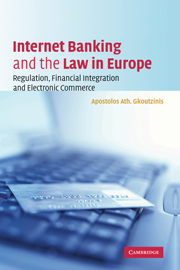Book contents
- Frontmatter
- Contents
- Tables
- Preface
- Tables of legislation
- Table of EU legislation
- Table of international conventions
- Table of cases
- Abbreviations
- Introduction
- PART I Introduction to electronic finance and Internet banking
- 1 Internet banking in Europe: basic concepts and recent trends
- 2 The legal foundations of electronic banking activities
- PART II Online banking and international market access: The causes of incomplete financial integration and what to do about them
- PART III EU harmonization and convergence of national laws relating to electronic banking activities
- PART IV Applicable law and allocation of regulatory responsibility in cross-border electronic banking activities
- Conclusions
- Select bibliography
- Index
2 - The legal foundations of electronic banking activities
Published online by Cambridge University Press: 11 August 2009
- Frontmatter
- Contents
- Tables
- Preface
- Tables of legislation
- Table of EU legislation
- Table of international conventions
- Table of cases
- Abbreviations
- Introduction
- PART I Introduction to electronic finance and Internet banking
- 1 Internet banking in Europe: basic concepts and recent trends
- 2 The legal foundations of electronic banking activities
- PART II Online banking and international market access: The causes of incomplete financial integration and what to do about them
- PART III EU harmonization and convergence of national laws relating to electronic banking activities
- PART IV Applicable law and allocation of regulatory responsibility in cross-border electronic banking activities
- Conclusions
- Select bibliography
- Index
Summary
The European law governing the contractual aspects of electronic banking activities is an amalgamation of the law of contracts, the law of the banker–customer relationship and, depending on the particular aspect of the service, the law governing distinct banking contracts and services, normally found in English common law and equity and, in the rest of Europe, in civilian codifications, such as the civil and the commercial codes of jurisdictions like France and Germany. A vast corpus of case law has further adapted these rules and principles to the special requirements of banking and financial practice. Moreover, specialist statutes, secondary statutory instruments and administrative regulations superimpose restrictions, rights and obligations in the pre-contractual and contractual stage, mainly for purposes of consumer, depositor and investor protection, transparency, disclosure and fairness in banking practice or, less frequently, economic and monetary policy. Finally, EU policies in the area of financial services and consumer protection are now firmly established as constant sources of national legal rules and institutions.
The banker–customer relationship
The relationship between the online bank and the customer is based on contract. It consists of a general contract, which comes into being upon the establishment of the banker–customer relationship, and special contracts, which arise only by specific agreement of the parties.
The bank account
The bank account is the foundation of separate and distinct contracts that come into being during the life of the banker–customer relationship.
- Type
- Chapter
- Information
- Internet Banking and the Law in EuropeRegulation, Financial Integration and Electronic Commerce, pp. 29 - 48Publisher: Cambridge University PressPrint publication year: 2006



